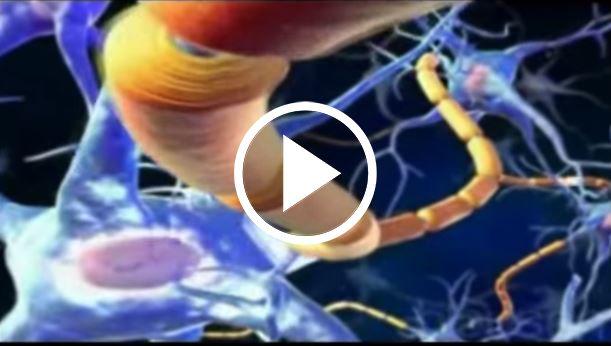Amyotrophic Lateral Sclerosis (ALS)

Amyotrophic lateral sclerosis (ALS), often referred to as “Lou Gehrig’s Disease,” is a progressive neurodegenerative disease that affects nerve cells in the brain and the spinal cord. Motor neurons reach from the brain to the spinal cord and from the spinal cord to the muscles throughout the body. The progressive degeneration of the motor neurons in ALS eventually leads to their death. When the motor neurons die, the ability of the brain to initiate and control muscle movement is lost. With voluntary muscle action progressively affected, patients in the later stages of the disease may become totally paralyzed.
A-myo-trophic comes from the Greek language. “A” means no or negative. “Myo” refers to muscle, and “Trophic” means nourishment–”No muscle nourishment.” When a muscle has no nourishment, it “atrophies” or wastes away. “Lateral” identifies the areas in a person’s spinal cord where portions of the nerve cells that signal and control the muscles are located. As this area degenerates it leads to scarring or hardening (“sclerosis”) in the region.
As motor neurons degenerate, they can no longer send impulses to the muscle fibers that normally result in muscle movement. Early symptoms of ALS often include increasing muscle weakness, especially involving the arms and legs, speech, swallowing or breathing. When muscles no longer receive the messages from the motor neurons that they require to function, the muscles begin to atrophy (become smaller). Limbs begin to look “thinner” as muscle tissue atrophies.
FACTS
- ALS is not contagious.
- It is estimated that ALS is responsible for nearly two deaths per hundred thousand population annually.
- Approximately 5,600 people in the U.S. are diagnosed with ALS each year. The incidence of ALS is two per 100,000 people, and it is estimated that as many as 30,000 Americans may have the disease at any given time.
- Although the life expectancy of an ALS patient averages about two to five years from the time of diagnosis, this disease is variable and many people live with quality for five years and more. More than half of all patients live more than three years after diagnosis.
- About twenty percent of people with ALS live five years or more and up to ten percent will survive more than ten years and five percent will live 20 years. There are people in whom ALS has stopped progressing and a small number of people in whom the symptoms of ALS reversed.
- ALS occurs throughout the world with no racial, ethnic or socioeconomic boundaries.
- ALS can strike anyone.
- The onset of ALS is insidious with muscle weakness or stiffness as early symptoms. Progression of weakness, wasting and paralysis of the muscles of the limbs and trunk as well as those that control vital functions such as speech, swallowing and later breathing generally follows.
- There can be significant costs for medical care, equipment and home health caregiving later in the disease. It is important to be knowledgeable about your health plan coverage and other programs for which your may be eligible, including SSA, Medicare, Medical and Veteran Affairs benefits.
- Riluzole, the first treatment to alter the course of ALS, was approved by the FDA in late 1995. This antiglutamate drug was shown scientifically to prolong the life of persons with ALS by at least a few months. More recent studies suggest Riluzole slows the progress of ALS, allowing the patient more time in the higher functioning states when their function is less affected by ALS.
Reports from three separate patient databases described long range experience with Riluzole. All three reports suggest a trend of increasing survival with Riluzole over time. More studies that are double blind and controlled are needed to confirm these database observations. The trend appears to indicate that longer periods of time than those used in the Riluzole clinical trials may be needed to see the long-term survival advantage of the drug. An interesting observation was that despite the fact that the Irish government provides Riluzole free of charge to people in Ireland with ALS, only two-thirds of the patients registered in the Ireland national ALS database reported taking Riluzole.
FORMS
Three classifications of ALS have been described:
- Sporadic – the most common form of ALS in the United States – 90 to 95% of all cases.
- Familial – occurring more than once in a family lineage (genetic dominant inheritance) accounts for a very small number of cases in the United States – 5 to 10% of all cases.
- Guamanian – an extremely high incidence of ALS was observed in Guam and the Trust Territories of the Pacific in the 1950’s.
The most common form of ALS in the United States is “sporadic” ALS. It may affect anyone, anywhere. “Familial” ALS (FALS) means the disease is inherited. Only about 5 to 10% of all ALS patients appear to have genetic or inherited form of ALS. In those families, there is a 50% chance each offspring will inherit the gene mutation and may develop the disease.
What is amyotrophic lateral sclerosis (ALS)?
ALS—often referred to as Lou Gehrig’s Disease or Motor Neuron Disease (MND)—is a progressive, degenerative disease affecting motor neurons. Motor neurons are specialized nerve cells that carry impulses from the brain to the muscles by way of the brainstem and the spinal cord. The muscles then move in response to these impulses.
In ALS, motor neurons gradually cease functioning and die. As this happens, the muscle tissues waste away because no movement is being stimulated. This results in gradually worsening muscle weakness, atrophy and often spasticity. Only the motor neurons are affected. Other nerve cells, such as sensory neurons that bring information from sense organs to the brain, remain healthy.
SYMPTOMS
Some of the early symptoms of ALS might include:
- Weakness or poor coordination in one limb
- Changes in speaking or swallowing
- Unusual muscle twitches, spasms or cramps
- Unusual weight loss or loss of muscle bulk
Typically, ALS affects motor neurons in both the brainstem and spinal cord. Symptoms related to the brainstem neurons (sometimes referred to as “bulbar symptoms”) can include spasticity or stiffness in the lower limbs, face or jaw. Feelings of heaviness, fatigue, stiffness and lack of coordination are common. Reflexes may be very brisk or exaggerated.
Unprovoked outbursts of laughter or crying can occur, a condition often referred to as “pseudobulbar affect” or “emotional lability.” Symptoms related to the spinal cord neurons (sometimes referred to as “somatic symptoms”) can include weakness, muscle wasting or muscle twitching.
It is important to remember that ALS strikes people in different ways. The symptoms and progression of the disease will be different from person to person.
DIAGNOSIS
The diagnosis of ALS is a “clinical diagnosis,” meaning there is no specific test for it. Often, tests will be administered to rule out illnesses with similar symptoms. These may include an MRI of the brain or spinal cord, an electromyography (EMG) study of nerve and muscle function, and a variety of blood and urine tests. After reviewing these test results and the patient’s medical history, and performing a complete neurological exam, a neuromuscular specialist can usually reach a diagnosis. It may take several months of observation and retesting to reach a definitive diagnosis and that diagnosis should be confirmed via a second opinion from another neuromuscular specialist.
PROGNOSIS
ALS progresses at different rates in each individual. The average survival for someone affected by ALS is three to five years. Fifty percent of those affected pass away within five years of diagnosis. A small percentage may live 10 years or more.
As the disease progresses, the patient usually experiences a decline in speech, swallowing and limb strength and function. Generally, ALS is not a physically painful condition, though discomfort can result from immobility and muscle shortening. The ALS patient usually remains alert and retains normal sensation, vision, bowel and bladder function. While most patients do not have loss of intellectual function, some may have subtle changes in mood, behavior or personality. In a small minority of patients, more significant changes in behavior and judgment suggest a form of dementia.
CAUSES
Approximately 10 percent of all ALS cases are inherited forms, known as “familial ALS.” Several genes have been identified that cause familial ALS. The remaining 90 percent of cases are called “sporadic ALS.”
In 2011, researchers, funded in part by the Les Turner ALS Foundation, identified a common cause of all forms of ALS: a broken-down protein “recycling system” in the neurons of the spinal cord and brain. Additional research is needed to determine how best to treat this faulty pathway.
TREATMENT
Many of the symptoms of ALS are treatable, but there are no drugs or treatments to cure the disease. However, patients may elect to take Rilutek©, the first FDA-approved medication for the treatment of ALS, as it has been shown to modestly increase lifespan. In addition, Nuedexta is approved by the FDA to treat pseudobulbar affect, a symptom that can occur in ALS/MND and other neurological conditions. Decisions regarding medication should be made in consultation with a neuromuscular specialist and should be part of a comprehensive treatment approach.
The quality of life of patients with ALS can often be improved by various treatments and interventions. Care provided by experts in multidisciplinary centers has been shown to prolong survival (Miller, et. al., 2009). Proper positioning, exercise, physical therapy and medications can help patients manage their symptoms. A feeding tube may be suggested if there is inadequate nutrition, extended meal times, rapid weight loss, high risk of aspiration (inhaling food or liquids into the lungs) or recurrent pneumonia. A wide range of devices and techniques can address problems with communication. Ultimately, ALS may result in sleep interruptions and changes in breathing, requiring consideration of airway clearance therapies. This may range from medications to non-invasive (mask) ventilation to a tracheostomy with mechanical ventilation. Managing symptoms is often a full-time responsibility for the patient and their caregivers. Connecting with a clinic such as the Les Turner/Lois Insolia ALS Center helps patients and their families to coordinate care in the best way.
SIMILAR DISEASES
ALS is the most serious disease among several that affect motor neurons. Other diseases in this group, called Motor Neuron Diseases (MND), include Spinal Muscular Atrophy (SMA), Primary Lateral Sclerosis (PLS) and Spinal Bulbar Muscular Atrophy (Kennedy’s Disease). Only a comprehensive examination by a neurologist can determine whether symptoms are caused by ALS or one of these other conditions.
.




